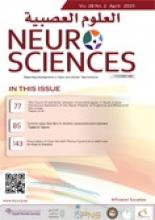Article Figures & Data
Tables
- Table 1
- Reasons for and against offering aducanumab and lecanemab to Saudi patients at this stage.
For Against Statistically significant cognitive and behavioral benefits were demonstrated in the EMERGE clinical trial The clinical significance of benefits demonstrated in the EMERGE trial is questionable Subgroup analysis of data collected from thr ENGAGE clinical trial showed cognitive benefits of a sufficient duration exposure to 10 mg/kg of aducanumab No statistically significant cognitive and behavioral benefits demonstrated in the ENGAGE trial Clarity-AD trial demonstrates benefit in AD patients Lecanemab is only supported with one trial with other trial results pending Effective, dose-dependent clearance of cerebral amyloid as determined by amyloid PET scance Clearance of cerebral amyloid has not been confirmed as a biomarker that correlated with clinical efficacy There is a huge unmet need to develop disease-modifying therapies for patients with AD and decrease the family and socioeconomic burdens of the disease There is a risk of doing harm and even increasing the risk of mortality associated with some forms of ARIA. Careful monitoring of AD patients throughout treatment is essential to detect early signs of ARIA Approving AD immunotherapies takes a long time; these are the first new for AD in nearly 2 decades Approval of new, potentially better, immunotherapies may be impending, eligibility for which may be complicated if patients were already treated with aducanumab Lack of representation of patients with different genetic and ethnic backgrounds in clinical trials Saudi-specific gaps in the patient care journey, including lack of streamlined clinical care pathways, definitively validated neuropsychological and behavioral assessment tools, availability of CSF and PET scan biomarkers - Table 2
- Consensus recommendations regarding clinical practice and resource requirements for developing AD immunotherapy programs in Saudi Arabia.
Clinical practice recommendations - A multidisciplinary cognitive and behavioral neurology clinic setting is required for AD immunotherapy programs.
- Supervision by neurologists, geriatricians and/or psychiatrists with subspecialty training in behavioral neurology is required.
- Offering treatment only to amnestic MCI or early AD patients who otherwise meet criteria for being good candidates for treatment, excluding patients with moderate and severe patients with AD, and patients with other forms of dementia or history or cerebrovascular events.
- Adherence to protocols of pivotal clinical trial of each of the immunotherapeutic agents being used, particularly with regards to inclusion criteria, dosing, neuropsychological and biomarker assessment, and frequent safety monitoring to detect and minimize the risks of ARIA.
- Collection of phase 4 data for medications not sufficiently demonstrated to be effective and safe in Saudi AD patients by extrapolation of data from phase III clinical trials
Resources and infrastructure- Recruitment and training of neurologists, geriatricians, and/or geriatric psychiatrists in cognitive and behavioral neurology or dementia
- Recruitment and training of neuropsychologists, psychotherapists and key supportive staff to work in dementia clinics
- Validating the minimum neuropsychological and behavioral psychometric tools: ADAS-Cog 13, MMSE, CDR, NPI, MCI-ADCS, others.
- Regular and immediate access to MRI scans- Access to reliable amyloid tests: amyloid PET scans and amyloid tracers
- Access to reliable and widely available testing of CSF a-beta42 and p-tau, apoE4 genetic testing






